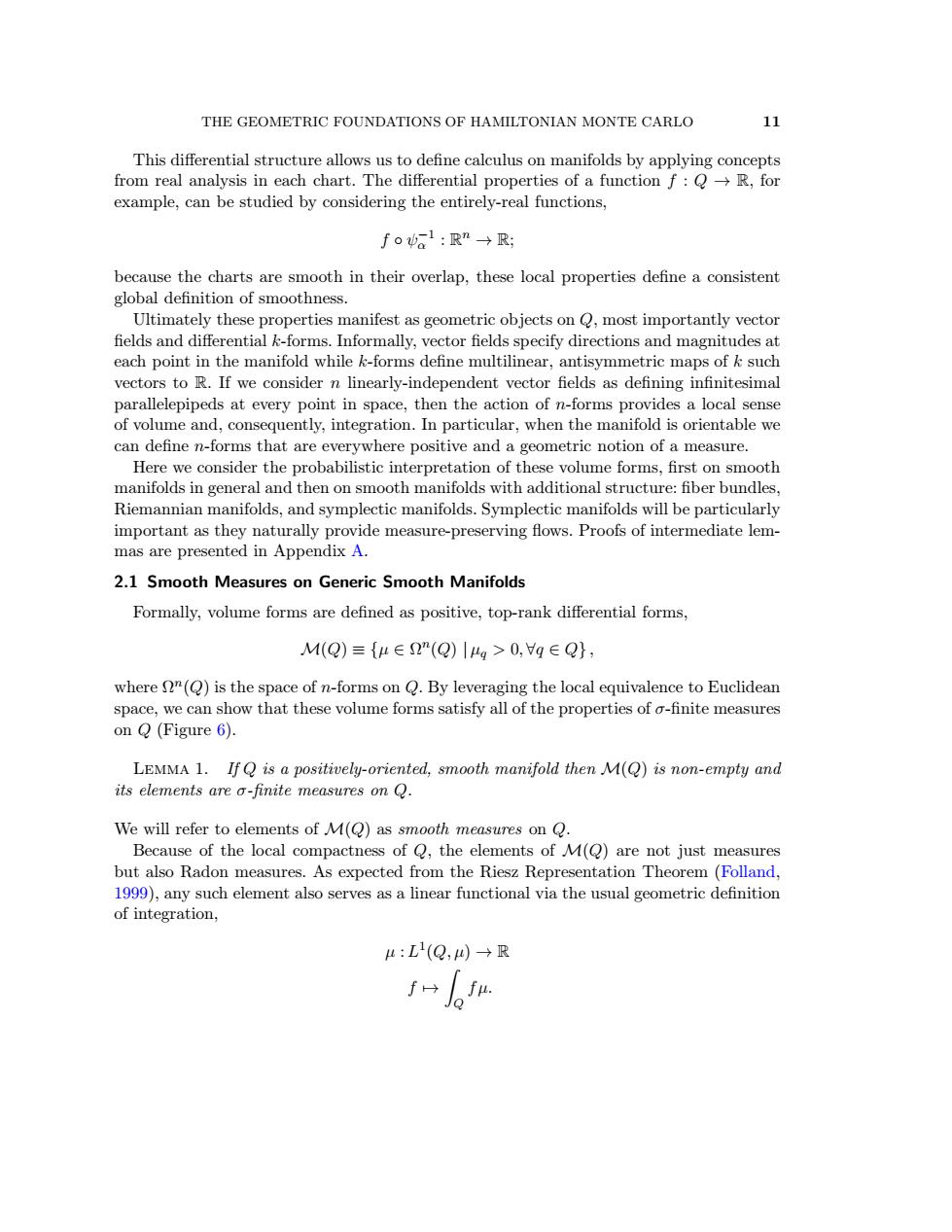正在加载图片...

THE GEOMETRIC FOUNDATIONS OF HAMILTONIAN MONTE CARLO 11 This differential structure allows us to define calculus on manifolds by applying concepts from real analysis in each chart.The differential properties of a function f:R,for example,can be studied by considering the entirely-real functions, fog1:Rn→R because the charts are smooth in their overlap,these local properties define a consistent global definition of ctor fields pecify c ections and magn to R.If we linearly-in r fields ng in eds at every p nt in spa en the orms prold es a loca r,when e m le we sider the pro comet. measure ifolds these voh forms,h n gen dditiona fiber b nifolds,and symplectic manifolds.Symp d c manit olds be pe de measure-preserving flows.Proofs of interme 2.1 Smooth Measures on Generic Smooth Manifolds Formally,volume forms are defined as positive,top-rank differential forms M(Q)={μ∈2"(Q)|>0,g∈Q}, where "(Q)is the space,we can s on Q(Figure 6). LEMMA 1.If Q is a positively iented,smooth manifold then M(Q)is non-empty and its elements are a-finit measures on Q. We will refer to elements of M(Q)as smooth measures on Q. Because of the local compactness of Q,the elements of M(Q)are not just measures but also Radon measures.As expected from the Riesz Representation Theorem (Folland, 1999),any such element also serves as a linear functional via the usual geometric definition of integration, 4:L(Q,)→R THE GEOMETRIC FOUNDATIONS OF HAMILTONIAN MONTE CARLO 11 This differential structure allows us to define calculus on manifolds by applying concepts from real analysis in each chart. The differential properties of a function f : Q → R, for example, can be studied by considering the entirely-real functions, f ◦ ψ −1 α : R n → R; because the charts are smooth in their overlap, these local properties define a consistent global definition of smoothness. Ultimately these properties manifest as geometric objects on Q, most importantly vector fields and differential k-forms. Informally, vector fields specify directions and magnitudes at each point in the manifold while k-forms define multilinear, antisymmetric maps of k such vectors to R. If we consider n linearly-independent vector fields as defining infinitesimal parallelepipeds at every point in space, then the action of n-forms provides a local sense of volume and, consequently, integration. In particular, when the manifold is orientable we can define n-forms that are everywhere positive and a geometric notion of a measure. Here we consider the probabilistic interpretation of these volume forms, first on smooth manifolds in general and then on smooth manifolds with additional structure: fiber bundles, Riemannian manifolds, and symplectic manifolds. Symplectic manifolds will be particularly important as they naturally provide measure-preserving flows. Proofs of intermediate lemmas are presented in Appendix A. 2.1 Smooth Measures on Generic Smooth Manifolds Formally, volume forms are defined as positive, top-rank differential forms, M(Q) ≡ {µ ∈ Ω n (Q) | µq > 0, ∀q ∈ Q} , where Ωn (Q) is the space of n-forms on Q. By leveraging the local equivalence to Euclidean space, we can show that these volume forms satisfy all of the properties of σ-finite measures on Q (Figure 6). Lemma 1. If Q is a positively-oriented, smooth manifold then M(Q) is non-empty and its elements are σ-finite measures on Q. We will refer to elements of M(Q) as smooth measures on Q. Because of the local compactness of Q, the elements of M(Q) are not just measures but also Radon measures. As expected from the Riesz Representation Theorem (Folland, 1999), any such element also serves as a linear functional via the usual geometric definition of integration, µ :L 1 (Q, µ) → R f 7→ Z Q fµ